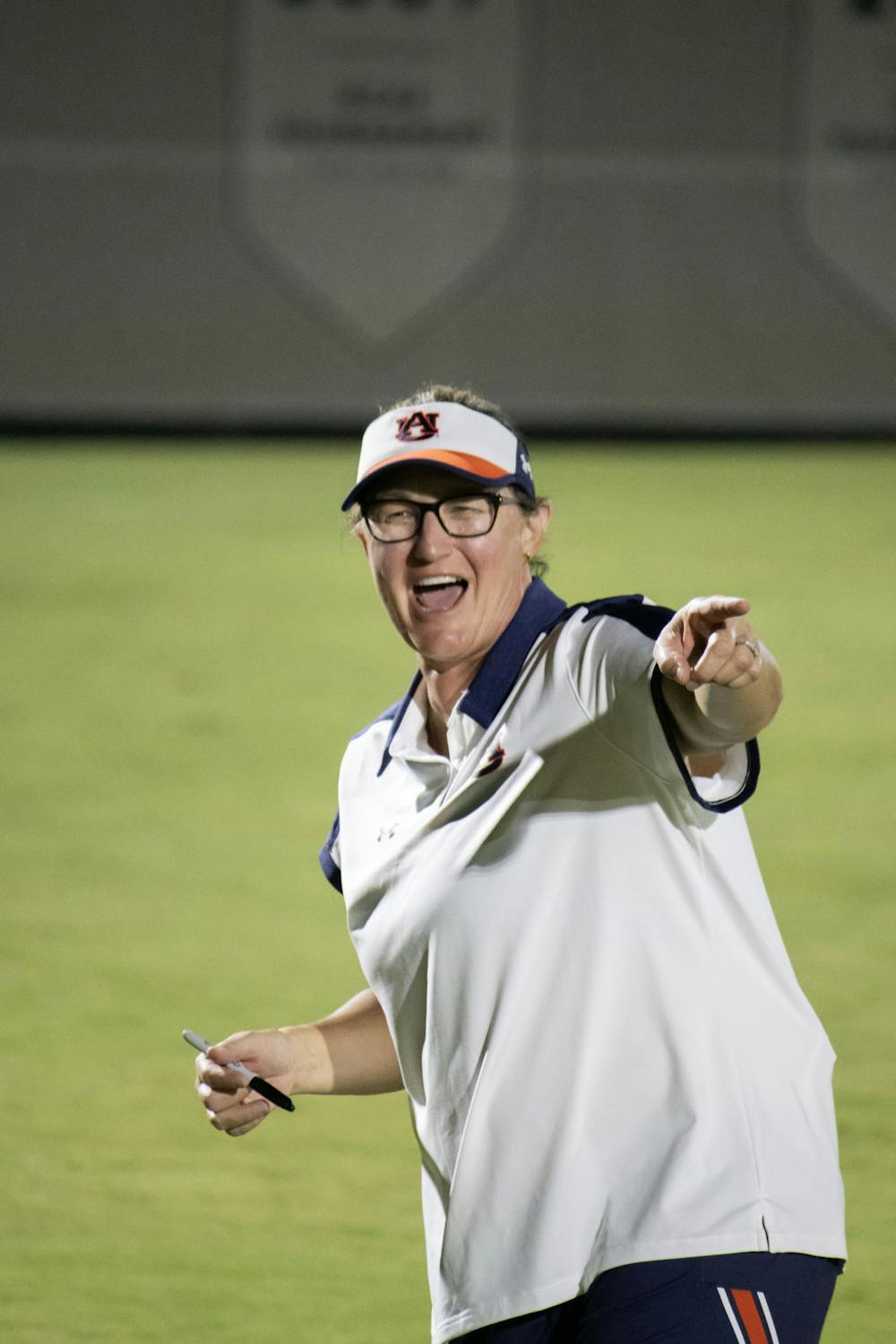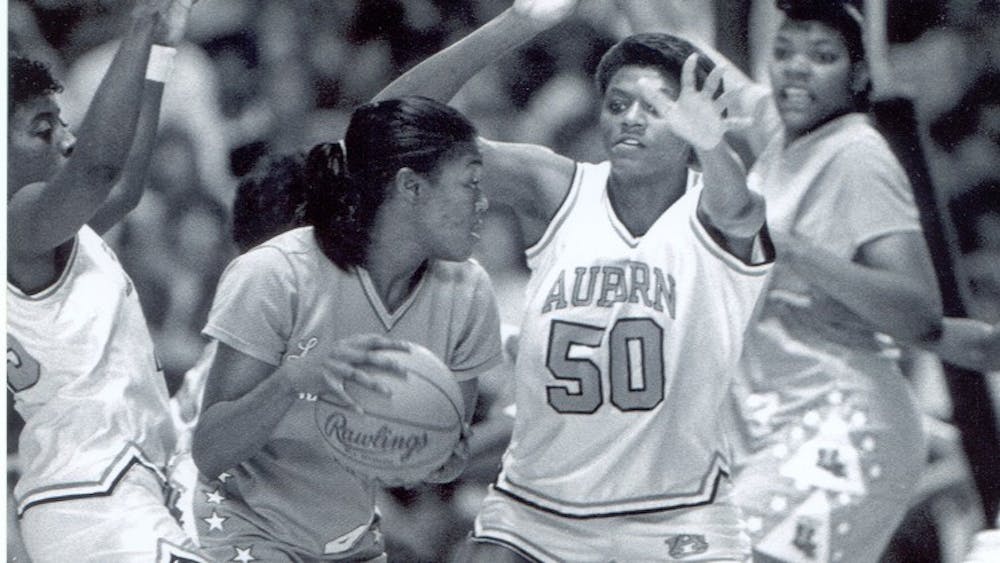In 1915, Nora Rothrock, Laura Watt, Annie Edwards, Eunice Stodghill, Barbara Wright, Mary Crenshaw, Francis Steele, Jane Smith, Margaret Duggar and Zelma Grimes became the first women in the history of Auburn University to compete in orange and blue. These women were the first members of the Auburn University “co-eds” basketball team which initiated a movement that would continue into the next century.
No record was kept of this team, with the exception of a team photograph found in the 1915 Glomerata, the Auburn University yearbook. They competed in what would be considered today as intramural games.
After the first mention in 1915, women’s athletics were not acknowledged or recognized in the Glomerata again until 1920, with a photograph of the basketball team that is believed to have played the first women’s intercollegiate game at Auburn. This team accomplished a record of 4-2, outscoring its opponents 136-79. However, after this era, the progressive movements of women’s athletics lost momentum.
For about the next 50 years, women’s athletics remained limited to club and intramural teams with little to no competition between universities. This persisted until the paramount signing of Title IX.
“No person in the United States shall, on the basis of sex, be excluded from participation in, be denied the benefits of, or be subjected to discrimination under any education program or activity receiving Federal financial assistance,” (signed by President Richard Nixon on June 23, 1972).
Susan Nunnelly, the voice of women’s basketball and an SEC trailblazer, came to Auburn University as a freshman in 1966. She graduated with her bachelor’s degree in education in 1970 and received her master’s degree in 1972, the same year Title IX was enacted. Nunnelly became the program’s second women’s basketball head coach in 1973 and coached for three seasons.
In the year of Title IX, Auburn University was under the leadership of President Harry M. Philpott and athletic director Lee Hayley.
“We were very fortunate because Coach Hayley was our athletic director, and he was very open to involving and bringing the women on board,” Nunnelly said. “So many schools had athletic directors that were not so open to it and felt like they were in some way going to intimidate and jeopardize their men’s program, which was not what Title IX ever intended to do.”
In the early days of women’s athletics, post Title IX, financial problems prospered as the women’s programs were solely funded by the physical education department. Nunnelly would make trips with both women’s volleyball and basketball to officiate games because if a team brought an official, the entry fee was waived, and they took every opportunity to save money.
“Sometimes the kids would drive their own cars... We would even play two games a day because we couldn’t afford to stay the night,” Nunnelly said.
1976 was a crucial year in the development of Auburn women’s athletics. The role of funding for women’s athletics was handed to the athletic department, and over the next decade, the budget grew from just $100,000 to about $1 million.
In the same year, professors who were acting as part-time coaches were replaced with full-time professional coaches. Facilities were enhanced, and Auburn was finally making headway in women’s athletics. However, there was still much work to be done.
Women’s teams often shared facilities with the men’s teams during this time. It became routine for the women’s volleyball team to put tape on the court before hosting a competition and have to take it off immediately following the match so that the men’s basketball team could practice. Other arrangements included doubleheader basketball games in which the women’s played first with a running clock. They played true 20-minute halves so that the men’s team could start on time due to radio or television contracts. As time went on and the women’s team gained a following, this concept became history.
Also in 1976, Hayley hired Joanna Davenport as the university’s first women’s athletic director. Davenport successfully improved scholarships and facilities for female athletes, with the first women’s athletic scholarship being awarded to volleyball player Sheila Smith.
By 1977, Auburn provided eight women’s sports which included basketball, golf, gymnastics, softball, swimming and diving, tennis, track and field and volleyball.
As women’s athletics continued to progress at Auburn University, Joe Ciampi, women’s basketball coach from 1979-2004, advanced women’s athletics with one of the most successful coaching careers in Auburn basketball history. Under Ciampi’s coaching, Auburn recorded three consecutive trips to the NCAA Final Four and four SEC Tournament Championships.
This was just the beginning as coach David Marsh led the women’s swim team to three NCAA Championships in the early 2000s, followed by Kim Evans with women’s golf who continuously competed in NCAA Championships, to today’s coaches who have made a lasting impact on women’s athletics.

Karen Hoppa, head coach of the Auburn women’s soccer team, is celebrating her 25th year as head coach.
Hoppa has been with the Tigers since 1999 and has accumulated an overall record of 272-181-51, collected seven SEC Western Division Championships and became the eighth female head coach to succeed 300 wins at a Division I level in the history of the sport.
“I think [women’s athletics] has really grown a ton and I’ve been able to see that not just with our sport, but among all the sports,” Hoppa said. “Just watching the way our student athletes get treated now is really a huge difference in a positive way since I started.”
Women’s athletics at Auburn University has changed vastly since the first women’s team in 1920 with the addition of athletic department participation, funding and Title IX, which has had an effect outside the realm of athletics.
“So many people are confused with Title IX that it just meant something to women in athletics, but that is not true,” Nunnelly said. “It helped women in every aspect, certainly all the careers. But thank goodness for athletics because I think we played a role that helped people realize that women are worth taking the chance.”
Do you like this story? The Plainsman doesn't accept money from tuition or student fees, and we don't charge a subscription fee. But you can donate to support The Plainsman.
Alexa Gardner is a junior at Auburn, majoring in exercise science. From Birmingham, Alabama, she started with The Plainsman in fall 2022.
Twitter: @alexagardner_





